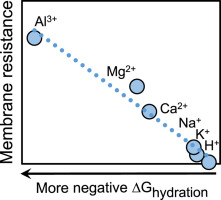当前位置:
X-MOL 学术
›
J. Membr. Sci.
›
论文详情
Our official English website, www.x-mol.net, welcomes your
feedback! (Note: you will need to create a separate account there.)
Impact of solution composition on the resistance of ion exchange membranes
Journal of Membrane Science ( IF 8.4 ) Pub Date : 2018-05-01 , DOI: 10.1016/j.memsci.2018.02.050 Shan Zhu , Ryan S. Kingsbury , Douglas F. Call , Orlando Coronell
Journal of Membrane Science ( IF 8.4 ) Pub Date : 2018-05-01 , DOI: 10.1016/j.memsci.2018.02.050 Shan Zhu , Ryan S. Kingsbury , Douglas F. Call , Orlando Coronell

|
Abstract Resistance to ion transport in ion exchange membranes (IEMs) is detrimental to the performance of IEM-based processes. In this work we measured the resistance of representative IEMs, i.e. one cation (CEM) and one anion (AEM) exchange membrane, in 15 single-salt solutions using electrochemical impedance spectroscopy. Resistance was sensitive to solute identity only in the case of the CEM for which it depended on the counter-ion identity; the resistance of the CEM was mostly insensitive to the co-ion identity, and the resistance of the AEM was mostly insensitive to both the counter-ion and co-ion identity. For all solutes, membrane resistance decreased sharply with increasing solution concentration below 0.1 M, and remained approximately constant above 0.1 M. An empirical mathematical model comprising a concentration-dependent term and a concentration-independent term successfully described membrane resistance as a function of solution concentration. The model builds on that previously proposed by Galama et al. (JMS 467 (2014), 279–291). We found that for both membranes, the concentration-dependent and concentration-independent terms of the resistance increased with increasing counter-ion hydration free energy. This was rationalized as the energy barrier to counter-ions having to shed/reorient water molecules of hydration, due to steric effects, when permeating the membranes. Also for both membranes, the concentration-dependent term of the resistance generally had a non-linear relationship with salt concentration. This result suggests that the concentration-dependent term is not attributable to bulk solution, and that there is a degree of randomness to the interconnectedness between the different membrane regions that contribute to ionic resistance. Our findings improve the understanding of the relationships between electrolyte properties and IEM resistance, and provide tools for assessing IEM resistance. This improved understanding is critical to establishing a complete IEM resistance theory and to evaluating new applications for IEMs.
中文翻译:

溶液组成对离子交换膜电阻的影响
摘要 离子交换膜 (IEM) 中对离子传输的抵抗对基于 IEM 的工艺的性能有害。在这项工作中,我们使用电化学阻抗谱测量了 15 种单盐溶液中代表性 IEM,即一种阳离子 (CEM) 和一种阴离子 (AEM) 交换膜的电阻。只有在 CEM 的情况下,电阻才对溶质特性敏感,因为它依赖于反离子特性;CEM 的电阻对共离子身份大多不敏感,而 AEM 的电阻对反离子和共离子身份大多不敏感。对于所有溶质,膜电阻随着溶液浓度增加到 0.1 M 以下而急剧下降,并且在 0.1 M 以上时保持大致恒定。包含浓度相关项和浓度无关项的经验数学模型成功地将膜电阻描述为溶液浓度的函数。该模型建立在 Galama 等人先前提出的模型之上。(JMS 467(2014),279-291)。我们发现,对于两种膜,电阻的浓度依赖项和浓度无关项都随着反离子水合自由能的增加而增加。这被合理化为抗衡离子在渗透膜时由于空间效应而必须脱落/重新定向水合水分子的能量屏障。同样对于两种膜,电阻的浓度依赖项通常与盐浓度呈非线性关系。该结果表明浓度依赖项不能归因于大量溶液,并且有助于离子电阻的不同膜区域之间的互连具有一定程度的随机性。我们的发现提高了对电解质特性与 IEM 电阻之间关系的理解,并提供了用于评估 IEM 电阻的工具。这种改进的理解对于建立完整的 IEM 阻力理论和评估 IEM 的新应用至关重要。
更新日期:2018-05-01
中文翻译:

溶液组成对离子交换膜电阻的影响
摘要 离子交换膜 (IEM) 中对离子传输的抵抗对基于 IEM 的工艺的性能有害。在这项工作中,我们使用电化学阻抗谱测量了 15 种单盐溶液中代表性 IEM,即一种阳离子 (CEM) 和一种阴离子 (AEM) 交换膜的电阻。只有在 CEM 的情况下,电阻才对溶质特性敏感,因为它依赖于反离子特性;CEM 的电阻对共离子身份大多不敏感,而 AEM 的电阻对反离子和共离子身份大多不敏感。对于所有溶质,膜电阻随着溶液浓度增加到 0.1 M 以下而急剧下降,并且在 0.1 M 以上时保持大致恒定。包含浓度相关项和浓度无关项的经验数学模型成功地将膜电阻描述为溶液浓度的函数。该模型建立在 Galama 等人先前提出的模型之上。(JMS 467(2014),279-291)。我们发现,对于两种膜,电阻的浓度依赖项和浓度无关项都随着反离子水合自由能的增加而增加。这被合理化为抗衡离子在渗透膜时由于空间效应而必须脱落/重新定向水合水分子的能量屏障。同样对于两种膜,电阻的浓度依赖项通常与盐浓度呈非线性关系。该结果表明浓度依赖项不能归因于大量溶液,并且有助于离子电阻的不同膜区域之间的互连具有一定程度的随机性。我们的发现提高了对电解质特性与 IEM 电阻之间关系的理解,并提供了用于评估 IEM 电阻的工具。这种改进的理解对于建立完整的 IEM 阻力理论和评估 IEM 的新应用至关重要。











































 京公网安备 11010802027423号
京公网安备 11010802027423号